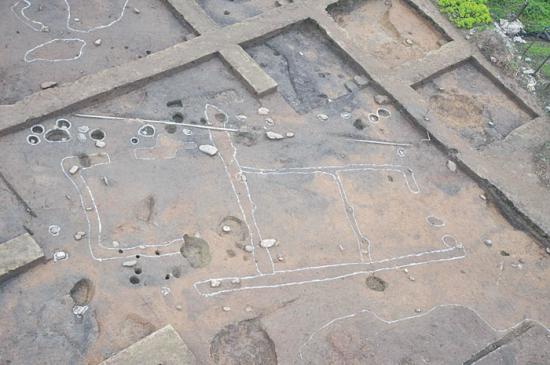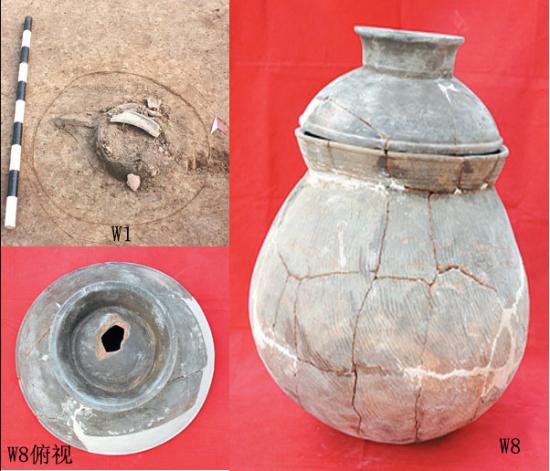A late Neolithic settlement site at Shuangfendian, Shiyan, Hubei
Chinese Institute of Archaeology
Source - http://www.kaogu.cn/en/detail.asp?ProductID=3516
The Shuangfendian site in the Lijiawan Village, Huanglong Town, Shiyan city, Hubei province, is located on the terrace of the both sides of the Jiang River, which is one of the branches of the upper reach of Han River. From June to September, 2009, the Archaeological team of the History Department of the Xiamen University carried out the first excavation at the site and the excavation covered 1500 m2. On the second level terrace of the south bank of the Jiang River, many relics features were found, including 5 large scale square houses remains(F2-F6), 24 ash pits and 17 urn coffins, etc. dating to the late Neolithic. In order to know more about the Shuangfendian site, the archaeological team, the History Department of the Xiamen University carried out the second excavation at the site from July to October, 2011. This excavation covered 2000m2 and discovered 6 buildings remains, 16 urn coffins, 29 ash pit and one pottery kiln and three tombs dating to the late Neolithic period. At the same time, a large number of stone tools and potteries dating to the late Shijiahe Culture were unearthed from ash pits and cultural layers. Compared to the excavation in 2009, the excavation in 2011 obtained more information about the layout of the Shuangfendian settlement.

The cemetery was generally located in the northwest of the site and was featured with intensive urn coffins. The urn coffins were mostly distributed around the houses and the coffins were mainly buckled with two guan 罐jars, ding 鼎 tripods, dou 豆 plates, pen盆basins, etc. No skeleton was found in the majority of the urn coffins, or only a little bone debris was remained, and grave goods were seldom discovered. In addition, obvious artificial perforation trace was found at the bottom of a small number of dou plates of the urn coffins. And stones were found at the brim of some urn coffins. For example, there was a rock at the brim of pottery tripods of urn burial W13.
The types of the houses were more than those discovered in 2009. Besides the lines of houses in northwest-southeast direction, there were single near square rooms with sundried mud bricks walls and the semi-subterranean houses discovered. Among them, F2 was the largest house with clearest structure. Inside F2, some remains were found, including a remained living surface, a cooking stove pit, remained wall foundation trench, some post-holes and some plinth stones. According to the remained conditions, F2 is presumed to be a rectangular above-ground row building and could be divided into three rooms, which were labeled as A, B and C from east to west. This building was facing to south, 14 meters long and 7.4 meters wide. The doorway was regular rectangular, slight east to the south wall foundation trench of the house, and was 0.9 meters wide. Moreover, there was a thicker layer of grey brown clay on the yellow sand earth and the grey brown clay was 0.1-0.2 meters thick. After being used for a long time, the living surface became smooth and some parts became green black or green yellow, green grey, and some parts had a layer of brown soil, which was generally 2-3cm thick. The foundation trench between Room B and Room C was narrow and only was 0.3-0.45 meters. Based on the row of the post-holes east to the north wall and to the south wall, it was possible that the roof was built outside the house with columns and eaves was formed. While there was sundried mud brick wall inside the house. The diversity of the houses’ type played a significant role for studying the development of the settlement at the Shuangfendian site.

The pottery production area was in the northwest of the site, relative independent from the core living area. Kiln Y1 was in racket shape with a longest diameter, about 285cm, a shortest diameter, 160cm, and a 60cm depth. The deposit inside the fire pool was red sand compact soil with fine burned brown soil debris in the south. At the bottom of the fire pool was a human skull, which was preserved well. This skull was similar with that discovered around the fire pool of the pottery kiln at the Qilihe site, Fang Town. It was assumed that this may have been a kind of ritual ceremony, representing the hunting heads tradition during the late Neolithic period in the northwest of Hubei province.

In 2011, a large number of stone tools were discovered in the ash pits and cultural deposits. The stone tools were made both by chipping and grinding. However, only a few were ground thoroughly. The tools were stone axes, adzes, chisels, arrowheads, pestles, gravels, etc. and a few scrapers made of quartz. While in the cultural deposit layers, ash pits and tombs, many potteries and pottery shards were discovered, dating to the Shijiahe Culture during the late Neolithic period. The potteries could be classified into sand clay and mud clay, but the majority was sand clay. The potteries were mainly red in color, but the minority was in grey or black. Most of the potteries were not decorated, however some of them were decorated with basket texture, rotation pattern, additional heap pattern, stamp image, and a few were tartan and string pattern. The types of the potteries were mostly thick embryo urns, ding tripods with wide and flat feet, funnel-shaped bowls, petal-shaped jars with ring feet, red clay bowls, cirrus hollow out holders. The mud clays were mostly polished black pottery and a few red pottery and grey pottery. Most of the potteries were not decorated, but there were a few basket texture and convex edge pattern. The pottery types were mostly round bottom jars with basket texture, black broad shoulders jars with straight neck, grey pottery basins with rolled brim, red cups, bowls, dou plates, jia tripods, spinning wheels etc. Through the comparison of the artifacts types and decorations, it could be primarily assumed that the Shuangfendian site was approximately equivalent to the phase I and II of the Shijiahe Culture at the Qilihe site, Fang Town.
The excavation and further study for the Shuangfendian site, supplied important value for further learning the human social change in the Jiang River, Du River, etc. which were the branches of the Han River, duing the late Neolithic period. (Translator: Zhai Shaodong)